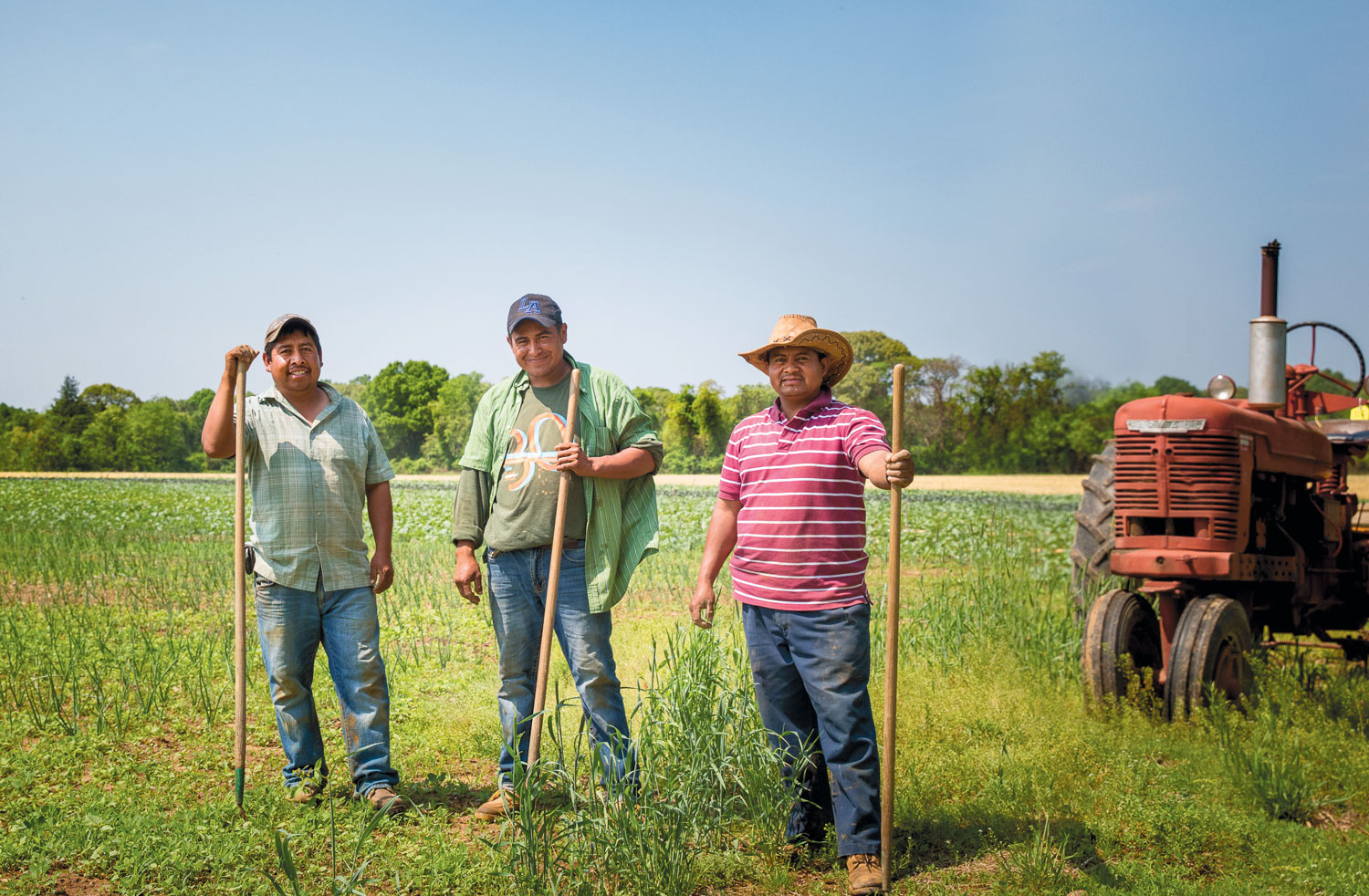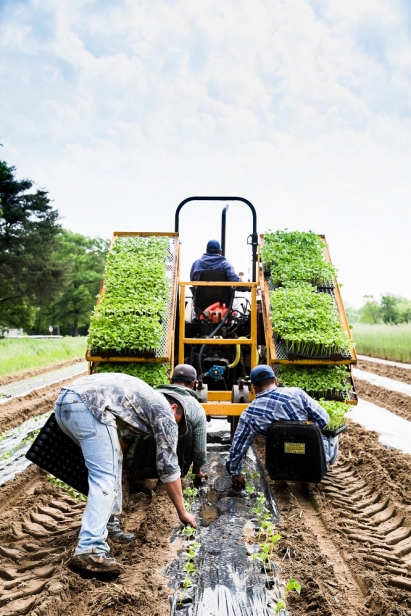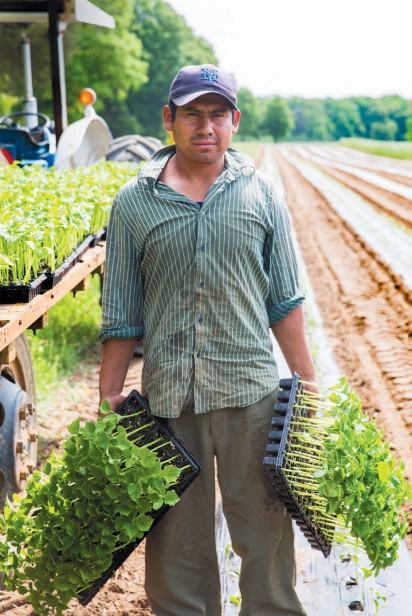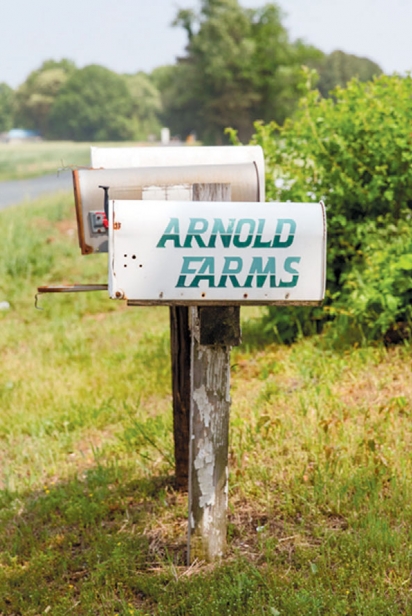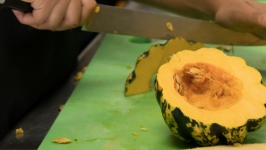Expanding the Family: Migrant Workers on the Eastern Shore
On Maryland’s Eastern Shore, migrant workers invest labor, love and ingenuity to help feed the community and the region
The first thing that greets you when turning down the lane to Arnold Farms in Chestertown, Maryland is Tess, a spunky pooch who seems to bask in her self-assumed role as farm mascot and greeter, barely able to contain the excitement of a visitor coming down the lane to check out her domain. And a beautiful domain it is, with fields of onions, tomatoes, cabbage, strawberries, wild flowers and more stretching outward in all directions.
A quick spin to take in the scenery reveals figures scattered throughout, peppering the fields as they till, bend, trim, plant, and generally command the cultivation of Arnold Farms’ beautiful 350 acres, 75 of which is harvested for vegetables. I stand and chat with owner Bob Arnold, and even from a distance I see the men briefly look up from their work to wave and smile before delving right back in. They’re no stranger to curiosity about their work and so welcome me as if I were a daily presence.
Arnold Farms has hired employees from Puebla, Mexico for years, tapping the federal H-2A Temporary Agricultural Workers program to legally bring on board foreign seasonal workers. These vital permit-holding personnel make possible the abundant harvesting of produce during the critical seven-month period between April and November. These men possess expertise necessary for Bob to hit the ground running when the season is at its most busy (and profitable); indeed, his crew perfectly illustrates how farm work requires a unique set of skills, a high level of aptitude, and teamwork. A few years back some of the workers introduced a method of tying tomatoes that was common back in Puebla, essentially cutting in half the time needed to complete this arduous task and limiting the physical toll that the previous constant stooping took.
Beyond their much-appreciated ingenuity with planting methods, Margaret Frothingham, the office genie who manages all administrative aspects of the farm’s operations, explains how the men are also fully proficient in the standard packing procedures required of the industry (such as rules regarding size and method), boast an impressive entomological knowledge, and are skilled in the operation of complex farm equipment. It’s clear how proud the employees are of their work as they explain which products are “theirs.” It’s important to men like Efrén, Santiago, and Guillermo that I, or rather we, know exactly what they have brought into the world by way of their work at Arnold Farms.
Arnold Farms continues a long tradition on the Maryland Eastern Shore of hiring workers by way of the H-2A program, launched in 1986 to address the longstanding issue of poor recruitment and retention of U.S. workers for farm jobs. To say that chronic labor shortages have been an issue in the world of agriculture would be an understatement, though also one that everyone at Arnold Farms seizes upon to emphasize the absolute reliance on the H-2A workforce. While it’s tricky to pin down a definitive answer as to why such labor shortages exist in the agricultural world and why recruitment and retention among nonimmigrant demographics happens, without them, farm production on the scale necessary to remain viable would simply cease to exist.
After fifteen years of grappling with this reality, Bob and Margaret hypothesize that the physical demands in often hot and humid temperatures wearing pants, long-sleeves, hats, and gloves (anything to protect ones’ skin) are simply too much for most to tolerate. The demands on Arnold Farms’ employees for expediency and efficiency to meet harvest goals and production deadlines mean that days start early and go long, frequent breaks aren’t likely, nor is it possible to spend too much time training individuals who have little or no experience in agricultural work.
The process for farms to obtain these crucial work visas is by no means easy. To receive the certification granting permission to apply for visas is arduous, a veritable maze of administrative government paperwork. Job opportunities must first be repeatedly advertised within the local community for U.S. workers and it is only then, when inevitably no interest is shown, that farmers are able to proceed with H-2A employee recruitment abroad. Adequate housing, transportation, and either food or access to methods of food preparation must be provided. A federally set wage of $12.05 an hour must be honored. Still, Arnold Farms and their Eastern Shore peers are adamant that the program provides irreplaceable quality and consistency of employees, who in turn, provide the community with good, healthy, affordable, well-produced food.
In the case of Arnold Farms, a consistent wage, room and board, good working conditions, and the support of their employer and broader community keeps the Puebla crew returning year after year. As Santiago tells me, “the whole work environment here and the way us workers are treated is such a good example for others to follow”.
Agriculture is the largest commercial industry in Maryland, with cash grains (such as corn and wheat) valuing at around $615 million annually, and fresh market fruit and vegetables representing an earning potential of $35 million or more. Upwards of fifty agricultural employers across the state of Maryland, including in six of the nine Eastern Shore counties, recruit around 700 employees by way of the H-2A program each year. And in fact, despite a political climate suggesting otherwise, the number of H-2A visa requests on behalf of agricultural institutions in the U.S. has doubled just this year alone. So, while some criticize the H-2A program as being expensive and cumbersome, most agree that it is absolutely essential to farms in Delmarva and across the nation.
The good news for Arnold Farms is that there remains no cap on H-2A visas like there is for its H-2B counterpart (for non-agricultural work), nor does it operate on the dreaded lottery system. H-2A visas have a maximum stay period of one year; all of Arnold Farms employees stay for seven months and then opt to return home to see their families, children, and patria for the remainder of the year. Many continue to work in agriculture, honing their craft to bring even more agronomic knowledge to Arnold Farms when the season cycles back around. Ernesto is a master beekeeper and commercializes his own honey. Efrén owns a famed street cart tamale business with his son, and several others do specialized work for granjas (farms with animals) or fincas (those exclusively with crops).
Seven months is a long time to spend away from one’s country and family. While it is not uncommon for wives and children to come for the season, the Puebla crew have chosen the less disruptive option of trekking northward alone in order to provide stability and consistency for their families. Luckily, it’s not difficult for families to stay connected via social media and messaging. Bob marvels at the crews’ tech savviness and, while he jokes that each of the guys is better with the web than he is, I suspect he admires their deftness to maintain contact with friends and family back home.
Despite the transient lifestyle, the Puebla crew and their H-2A peers have become a part of the local fabric. Each spring, Washington College in Chestertown sponsors an event to promote wellness through a day of soccer-filled fun, and the Arnold Farms team is front and center participating. This is, unsurprisingly, not the only outlet for some friendly soccer competition– the men venture down to Cambridge to play in a local soccer league when they can.
Bob’s wife Sarah Arnold, who teaches English as a Second Language for the local school system and is a champion for each of the farms’ employees, describes the celebratory Hispanic Heritage Night hosted by the Sudlersville schools as an evening of music, delicious foods, games, and comradery that has grown over the years to now boast hundreds of attendees. Additionally, Kent and Queen Anne’s Counties operate a summer school program in which many migrant children continue their education while their parents work in the fields. And there is a bilingual weekly mass offered at St. Dennis Church in Galena, plus picnic fundraisers and other events sponsored by the parish. Chances of seeing the Arnold Farms men and their fellow H-2A workers there lending a hand and mingling with the Latino and non-Latino community alike are almost guaranteed.
When employers and employees alike are asked what they would like the community to know about them and their work, answers reveal an ardent defense of H-2A immigrant labor and an invitation to be better informed about the system and people involved. Bob is emphatic about the point that his employees are educated in their craft and are skillful contributors to so many aspects of his immediate community. For Margaret and Sarah, what strikes them with a poignant urgency is how utterly irreplaceable their H-2A work crews are and their esteem for their men who are living a transcultural life. So important to note here is how much of a family unit has formed over the years between Bob, Sarah, Margaret and their employees. There is a palpable and admirable sense of genuine care for the wellness of the crew that without a doubt inspires the dedication and work ethic among the men that is so obvious when visiting the farm. During my recent visit, Efrén, Santiago, Carlos and others speak to this point constantly.
The most impactful answers are those offered by the Arnold Farms’ Puebla crew themselves. Besides a strong call to join them in the fields to see what the work is like (and how good they really are at their jobs), each expresses a desire for people to know which products he produces, quite literally, from the ground up. They ask for people to consider what it’s like to leave one’s home country and attempt to navigate all that comes with such a venture, even when it is temporary and with an expressly stated purpose.
“Perhaps some folks find it hard to identify with the need we have to separate from our families and children in order to earn enough money to support them, to literally survive, because it’s so different here,” says Guillermo, who categorically hits the nail on the head for the rest, who all nod in agreement. They are proud of their work and proud to feed the families of the Maryland community in which they live, in turn giving them the ability to feed their own families at home.
Bob Arnold’s t-shirt says it all: Immigrants Feed America. While the bread-and-butter for Arnold Farms comes from cabbage, squash, sweet corn and tomatoes, much of the labor, love and innovation comes from the Puebla workers. For the contributions they and their counterparts make each season to our food, our farms and our communities, we are thankful.
Visit Arnold Farms on Facebook and check out their produce at the weekly Chestertown Farmer’s Market


